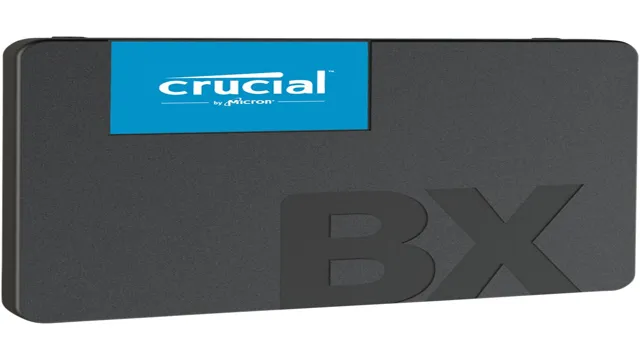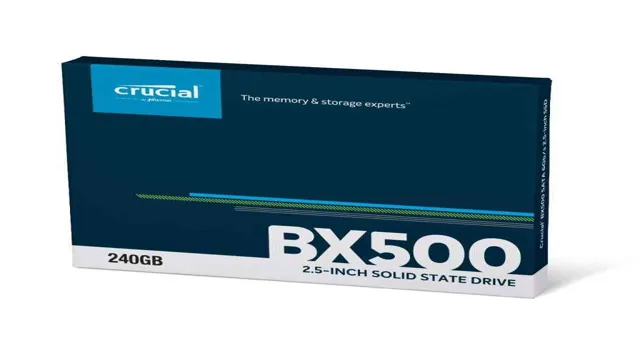Did you just install your new Crucial SSD? Congratulations! You’re about to experience faster boot times, improved performance, and increased storage space. However, before you start using your new SSD, it’s crucial to confirm that it’s installed correctly. Not doing so could lead to potential issues like data loss or performance problems.
In this blog post, we’ll guide you through the steps to confirm your Crucial SSD installation so that you can reap the full benefits of your new purchase. So, sit back, relax, and let’s get started!
Check Your Device Manager
If you recently installed a Crucial SSD and you’re not sure whether it’s working, one way to confirm it is by checking your Device Manager. This tool is built into your computer’s operating system and displays all the devices that are installed on your computer. Once you open the Device Manager, look for the “Disk Drives” category and click on it.
If you see your new SSD listed there, but with a yellow triangle or exclamation point icon next to it, it might indicate that the device driver is missing or needs updating. In that case, you’ll need to locate and install the correct driver for your SSD. On the other hand, if you see your SSD listed without any symbols, it means that your SSD has been recognized by your computer and is functioning properly.
This way, you can be sure that your Crucial SSD has been installed correctly and is ready to use.
Open Device Manager in Windows
If you’re experiencing issues with your computer hardware, one of the first places to check is your device manager. Think of it as a directory of sorts for all the components that make up your system. To access it on Windows, simply right-click on the Start button and select “Device Manager.
” You can also search for it in the Windows search box. Once open, you’ll see a list of every device connected or built into your computer, from your keyboard and mouse to your graphics card and network adapter. If there’s a problem with a particular device, it should have a yellow exclamation mark or red X over its icon.
From here, you can update, reinstall, or disable certain devices to troubleshoot the issue. Don’t be intimidated by the technical jargon – with a little bit of knowledge, you can take control of your computer and ensure it’s running smoothly.

Verify Your Crucial SSD is Listed
When it comes to verifying if your crucial SSD is listed, one of the easiest ways to do so is to check your device manager. This can be accessed by right-clicking on the start menu and selecting “device manager” from the list. Once open, look for the “disk drives” section and expand it to see if your SSD is listed.
If it is not listed, there may be an issue with the connection or installation of the drive. However, it is important to note that some SSDs may appear as “standard SATA AHCI controller” or something similar, so it is worth checking all of the options listed before assuming your SSD is not recognized. By checking the device manager, you can quickly and easily determine if your crucial SSD is installed correctly and ensure optimal performance of your system.
Update Your Drivers if Necessary
If you’re experiencing issues with your computer or device, especially after a recent software update, the problem may lie with outdated or corrupted drivers. Luckily, updating your drivers is a relatively simple process that can save you a lot of headaches. The first step is to check your Device Manager, which lists all of the hardware components and peripherals connected to your computer.
Look for any drivers that have a yellow exclamation mark next to them, as this indicates an issue. Right-click on the device and select “Update Driver Software” to automatically search and download the latest driver. Alternatively, you can visit the manufacturer’s website to manually download and install the updated driver.
By keeping your drivers up-to-date, you’ll ensure that your hardware components work properly and prevent any potential security vulnerabilities.
Test Your Crucial SSD’s Performance
After installing a new Crucial SSD, it’s essential to confirm it’s operating at its optimal level. One way to do this is by running a performance test. First, ensure that the SSD has been properly connected and initialized.
Next, download benchmarking software such as CrystalDiskMark or ATTO Disk Benchmark. These programs will measure the read and write speeds of the Crucial SSD, giving you an idea of its performance. It’s important to note that the results may differ based on the capacity and model of your Crucial SSD.
To get an accurate benchmark, close any other applications and avoid multitasking during the test. If the results show that the Crucial SSD is operating below its expected speed, try updating the firmware or contacting Crucial support. Overall, checking the performance of your Crucial SSD is a straightforward process that can help you get the most out of your investment.
Use CrystalDiskMark for Benchmarking
When it comes to testing the performance of your Crucial SSD, one of the best benchmarking tools you can use is CrystalDiskMark. This free software allows you to run various types of tests to assess the read and write speeds of your drive. By doing so, you can determine if your SSD is running at the optimal level and detect any potential issues that might be affecting its performance.
The program is easy to use and provides detailed results that are easy to interpret. Just keep in mind that while higher benchmark scores are better, they don’t always reflect real-world performance, so don’t rely solely on them to make an informed decision about your hardware. So, if you want to gauge your SSD’s performance, give CrystalDiskMark a try and see how it fares!
Run a Speed Test on Your System
If you’re looking to test the performance of your Crucial SSD, running a speed test is a great way to get started. Testing your SSD’s performance can help you identify any potential issues and ensure that it’s running at optimal levels. One of the easiest ways to test your SSD’s performance is to use a tool like CrystalDiskMark.
This software provides a comprehensive overview of your SSD’s read and write speeds, as well as other performance metrics. By running a speed test, you’ll be able to see how your SSD compares to other drives on the market and ensure that it’s performing at the level you expect. So, if you want to get the most out of your Crucial SSD, take the time to run a speed test today and get a better understanding of its performance.
Final Checks for Peace of Mind
Once you’ve installed a new SSD in your computer, it’s important to perform some final checks to ensure everything has been properly installed and configured. First, check your computer’s BIOS to confirm that the SSD is recognized and listed as the primary boot drive. This is essential for ensuring optimal performance and speed.
Next, run a benchmark test to verify that the SSD is operating at the expected level of performance. You can use free tools like CrystalDiskMark or ATTO Disk Benchmark to perform these tests. Finally, check your operating system settings to make sure that they are configured to take full advantage of your new SSD.
This means enabling TRIM (for Windows) or enabling APFS (for macOS). By performing these crucial checks, you can confirm that your new SSD is properly installed and optimized for peak performance.
Verify Your Operating System is on the SSD
When it comes to ensuring optimal performance from your computer, it’s crucial to verify that your operating system is indeed installed on the SSD. This final check can bring peace of mind and help you get the most out of your system. Having your OS on the SSD ensures faster boot times, launch speeds, and overall system responsiveness.
To check, simply go to your computer’s system properties and look for the location of your OS. If it’s on the SSD, you’re good to go! If not, it’s recommended that you transfer it to the SSD to fully enjoy the benefits of the solid-state drive. A little bit of extra effort towards this step can go a long way and make a significant difference in your computer’s performance.
Check Your BIOS Settings
When it comes to ensuring your computer is running smoothly, one important final check is to review your BIOS settings. BIOS (Basic Input/Output System) is the firmware that controls your computer’s hardware. By checking your BIOS settings, you can make sure that all your hardware components are functioning correctly.
This includes making sure your CPU is running at the correct speed, your RAM is detected, and your storage drives are recognized. Making adjustments to your BIOS settings can also help improve your computer’s performance. So, before you complete your computer setup, take a few minutes to familiarize yourself with your BIOS settings and ensure everything is optimized for peak performance.
Enjoy Your Fast and Reliable System
So, you’ve purchased your new Crucial SSD and you want to confirm that it’s installed correctly? Don’t worry, we’ve got you covered. First things first, before you begin the installation process, make sure that your computer is turned off and unplugged. If you’re replacing an old hard drive with your new SSD, make sure to remove the old hard drive before proceeding.
Once you’ve installed your new Crucial SSD, you can confirm it’s working properly by checking your computer’s system information. On a Windows computer, go to the start menu, search for “Device Manager”, and click on “Storage controllers”. Your Crucial SSD should be listed here.
On a Mac computer, go to “System Information” and select “NVMe / SATA”. Another way to confirm that your Crucial SSD is installed and functioning properly is to test its speed. You can use various free benchmarking programs online to test your SSD’s speed.
Remember that the speed of your SSD can also be affected by the type of connection it has with your computer. For best results, make sure that your new Crucial SSD is connected via SATA III cable or NVMe. In conclusion, confirming your Crucial SSD installation doesn’t have to be complicated.
By following these simple steps, you can ensure that your new SSD is installed correctly and performing at optimal speed. Enjoy your fast and reliable system with your new Crucial SSD!
Conclusion
In conclusion, confirming the installation of your crucial SSD is as crucial as the SSD itself. It’s like being certain that the cake is actually in the oven before assuming it will be perfectly baked. In the same way, confirming the installation of your SSD ensures that it is properly connected and functioning as it should.
So, don’t be in doubt, take the time to double-check the installation and enjoy the speedy performance of your upgraded system!”
FAQs
What is a crucial SSD?
A crucial SSD is a type of solid-state drive from Crucial, a well-known brand in data storage solutions.
How do I confirm if my Crucial SSD is installed correctly?
You can confirm if your Crucial SSD is installed correctly by checking the system information on your device, or by using a diagnostic tool provided by Crucial.
Is it necessary to install a Crucial SSD in a specific way?
Yes, it is important to follow the installation guidelines provided by Crucial, to ensure that your SSD is installed correctly and functions properly.
What are the benefits of installing a Crucial SSD?
Installing a Crucial SSD can improve your computer’s speed and performance, as well as provide better data storage and reliability. Additionally, it can also prolong the lifespan of your device.
